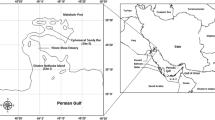Abstract.
Concentrations of selenium and five heavy metals (lead, cadmium, mercury, chromium, and manganese) in the eggs of herring gulls (Larus argentatus) were studied at six breeding colonies in the New York Bight to detect locational differences and to explore their use as a bioindicator of point source or nonpoint source pollution. The herring gull is widespread in North America, Europe, and Asia, and has urban-adapted counterparts in the southern hemisphere as well. We anticipated that the chromium contamination at Jersey City and high levels of manganese in industrial releases to the Passaic River would be reflected in the nearest colony (Shooter's Island), and that lead contamination from bridge remediation would be apparent in the Jamaica Bay colonies. There were significant locational differences in all metal levels, although the patterns were not the same for all metals. Shooter's Island in Newark Bay ranked first or second for five of the elements, but inexplicably had the lowest mercury level. Cadmium levels were highest at Canarsie Pol in Jamaica Bay, but mercury levels were highest at the relatively isolated Lavallette colony in northern Barnegat Bay. Chromium and manganese levels were indeed highest at Shooter's Island, but the lead levels in Jamaica Bay were only intermediate. We predicted that the essential trace elements, manganese, chromium, and selenium, which are known to be present at relatively high concentrations in various animal species, would have relatively low coefficients of variation, reflecting homeostatic mechanisms. This was confirmed. In conclusion, herring gull egg contents can be used to monitor metal concentrations at nearby colonies to indicate areas of concern for particular metals. They may confirm suspected associations or identify hitherto unsuspected problems.
Similar content being viewed by others
Author information
Authors and Affiliations
Additional information
Received: 22 June 1996/Accepted: 14 October 1996
Rights and permissions
About this article
Cite this article
Gochfeld, M. Spatial Patterns in a Bioindicator: Heavy Metal and Selenium Concentration in Eggs of Herring Gulls (Larus argentatus) in the New York Bight . Arch. Environ. Contam. Toxicol. 33, 63–70 (1997). https://doi.org/10.1007/s002449900224
Issue Date:
DOI: https://doi.org/10.1007/s002449900224




